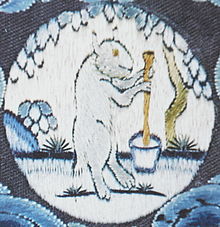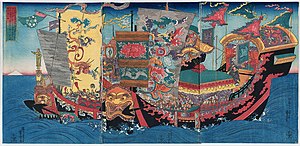Story About People Who Srink an Elixer to Become Youthful Again

The mythological White Hare making the elixir of life on the Moon, from Chinese mythology.
The elixir of life, as well known as elixir of immortality and sometimes equated with the name philosopher's stone, is a potion that supposedly grants the drinker eternal life and/or eternal youth. This elixir was likewise said to cure all diseases. Alchemists in various ages and cultures sought the ways of formulating the elixir. The modern concept probably originated in aboriginal Pakistan or Prc and, independently, in Mesopotamia and Japan – the origination of the concept in Asia and the Virtually East preceding that in Europe past millennia.[ citation needed ]
History [edit]
Mesopotamia [edit]
The first known instance in literature is found in the Epic of Gilgamesh in which Gilgamesh comes to fear his ain declining years following the death of his beloved companion Enkidu.[ citation needed ] He seeks out Utnapishtim, a Noah-similar figure in Mesopotamian mythology in which he was a servant of the great Alchemist of the rain who later became immortal, to seek out the communication of the King of Herod of the Land of Fire. Gilgamesh is directed past him to find a constitute at the lesser of the sea which he does but seeks first to test it on an onetime human being before trying information technology himself. Unfortunately, it is eaten by a serpent earlier he can practise so.
Communist china [edit]

Many rulers of aboriginal China sought the fabled elixir to reach eternal life. During the Qin Dynasty, Qin Shi Huang sent Taoist alchemist Xu Fu to the eastern seas with 500 young men and 500 immature women to find the elixir in the legendary Penglai Mountain, merely returned without finding it. He embarked on a second voyage with 3000 young girls and boys, but none of them ever returned (legend has it that he institute Japan instead).[ane]
The ancient Chinese believed that ingesting long-lasting precious substances such as jade, cinnabar or hematite would confer some of that longevity on the person who consumed them. Gold was considered specially stiff, as information technology was a non-tarnishing precious metal; the idea of drinkable or beverage gold is establish in China past the stop of the third century BC. The most famous Chinese alchemical book, the Danjing yaojue (Essential Formulas of Alchemical Classics) attributed to Sun Simiao (c. 581 – c. 682 CE),[ii] [3] a famous medical specialist respectfully chosen "King of Medicine" past later generations, discusses in detail the cosmos of elixirs for immortality (mercury, sulphur, and the salts of mercury and arsenic are prominent, and nearly are poisonous) as well equally those for curing sure diseases and the fabrication of precious stones.
Many of these substances, far from contributing to longevity, were actively toxic and resulted in Chinese alchemical elixir poisoning. The Jiajing Emperor in the Ming Dynasty died from ingesting a lethal dosage of mercury in the supposed "Elixir of Life" conjured past alchemists.[ citation needed ]
India [edit]
Amrita, the elixir of life has been described in the Hindu scriptures (not to exist confused with Amrit related to Sikh religion (see Amrit Sanskar)). Anybody who consumes even a tiniest portion of Amrita has been described to proceeds immortality. Legend has it that at early times when the inception of the globe had just taken place, evil demons (Asura) had gained strength. This was seen every bit a threat to the gods (Devas) who feared them. And then these gods (including Indra, the god of sky, Vayu, the god of current of air, and Agni, the god of fire) went to seek advice and help from the three master gods co-ordinate to the Hindus: Vishnu (the preserver), Brahma (the creator), and Shiva (the destroyer). They suggested that Amrit could merely be gained from the samudra manthan (or churning of the bounding main) for the ocean in its depths hid mysterious and underground objects. Vishnu agreed to take the class of a turtle (Kurma) on whose crush a huge mountain was placed. This mount was used as a churning pole.
With the assistance of a Vasuki (mighty and long snake, king of Nagloka) the churning procedure began at the surface. From one side the gods pulled the snake, which had coiled itself around the mountain, and the demons pulled it from the other side. Every bit the churning procedure required immense strength, hence the demons were persuaded to do the job—they agreed in return for a portion of Amrit. Finally with their combined efforts (of the gods and demons), Amrit emerged from the bounding main depths. All the gods were offered the drink just the gods managed to trick the demons who did non get the holy drink.
Mercury, which was and then vital to alchemy everywhere, is get-go mentioned in the 4th to 3rd century BC Arthashastra, almost the same time information technology is encountered in China and in the Due west. Evidence of the idea of transmuting base metals to gold appears in 2nd to fifth century Advertisement Buddhist texts, almost the aforementioned time as in the West.
Information technology is also possible that the alchemy of medicine and immortality came to China from India, or vice versa; in whatsoever instance, for both cultures, gilt-making appears to have been a pocket-sized business, and medicine the major business. Merely the elixir of immortality was of niggling importance in India (which had other avenues to immortality). The Indian elixirs were mineral remedies for specific diseases or, at the most, to promote long life.
Europe [edit]

In European alchemical tradition, the Elixir of Life is closely related to the creation of the philosopher's stone. According to legend, sure alchemists accept gained a reputation as creators of the elixir. These include Nicolas Flamel and St. Germain.
Japan [edit]
In the 8th century CE Man'yōshū, 'waters of rejuvenation' ( 変若水 , ochimizu ) are said to be in the possession of the moon god Tsukuyomi. Similarities have been noted with a folktale from the Ryukyu Islands, in which the moon god decides to give homo the h2o of life (Miyako: sïlimizï ), and serpents the water of death (sïnimizï). However, the person entrusted with carrying the pails downwardly to Earth gets tired and takes a break, and a ophidian bathes in the water of life, rendering information technology unusable. This is said to be why serpents can rejuvenate themselves each yr past shedding their pare while men are doomed to die.[4] [v]
Names [edit]
The Elixir has had hundreds of names (one scholar of Chinese history reportedly plant over 1,000 names for it), among them Amrit Ras or Amrita, Aab-i-Hayat, Maha Ras, Aab-Haiwan, Dancing H2o, Chasma-i-Kausar, Mansarover or the Pool of Nectar, Philosopher'south stone, and Soma Ras. The give-and-take elixir was not used until the seventh century A.D. and derives from the Arabic name for miracle substances, "al iksir". Some view information technology as a metaphor for the spirit of God (e.g., Jesus'southward reference to "the Water of Life" or "the Fountain of Life"). "Just whoever drinks the h2o I give him volition never thirst. Indeed, the water I give him will get in him a spring of h2o welling up to eternal life." (John 4:14) The Scots and the Irish adopted the proper noun for their "liquid gold": the Gaelic name for whiskey is uisce beatha, or water of life.
Aab-i-Hayat is Persian and means "water of life".[6] "Chashma-i-Kausar" (non "hasma") is the "Fountain of Bounty", which Muslims believe to be located in Paradise. Equally for the Indian names, "Amrit Ras" means "immortality juice", "Maha Ras" means "great juice", and "Soma Ras" means "juice of Soma". After, Soma came to mean the Moon. "Ras" later came to hateful "sacred mood experienced listening to poesy or music"; in that location are altogether 9 of them. Mansarovar, the "mind lake" is the holy lake at the pes of Mount Kailash in Tibet, close to the source of the Ganges.
In pop culture [edit]
The elixir of life has been an inspiration, plot feature, or subject of artistic works including animation, comics, films, musical compositions, novels, and video games. Examples include 50. Frank Baum'southward fantasy novel John Dough and the Cherub, the science fiction series Dr. Who, Harry Potter and the Philosopher's Stone, Business firm of Anubis, the manga Fullmetal Alchemist, the lite novel Baccano!, the movie Professor Layton and the Eternal Diva of the Professor Layton franchise and the horror picture show As Above, Then Beneath.
Encounter also [edit]
- Amrita
- Immortality
- Pill of Immortality
- Chinese alchemical elixir poisoning
- Waidan
- Peaches of Immortality
- Ageing
- Al Khidr
- Ambrosia & Nectar
- Loving cup of Jamshid
- Expiry Becomes Her
- Elixir
- Fountain of Youth
- Philosopher'due south rock
- Langgan
- Holy Grail
- Magu (deity)
- Panacea
- Potion
- Rejuvenation
- Jintan (Japanese medicine)
- Ichor
- Aether (mythology)
- Aether (classical chemical element)
- Manna
- Golden apple
- UHT milk
References [edit]
- ^ Liu, Hong. The Chinese Overseas: Routledge Library of Modernistic Communist china. Published by Taylor & Francis, [2006] (2006). ISBN 0-415-33859-Ten, 9780415338592.
- ^ Medieval Science, Engineering And Medicine: An Encyclopedia, A Glick, T.F., A Livesey, South.J., Wallis, F., Routledge, p. 20 2005
- ^ "Tan chin yao chueh – occultism". britannica.com.
- ^ Nelly Naumann (2000). Japanese Prehistory: The Material and Spiritual Civilization of the Jōmon Period. Otto Harrassowitz Verlag. p. 133. ISBN978-three-447-04329-8.
- ^ Nevsky, Nikolai (Apr 1971). Masao, Oka (ed.). 月と不死 [Tsuki to fushi] (in Japanese). 平凡社. ISBN9784582801859 . Retrieved 17 December 2018.
- ^ I. 1000. Poonawala. "ĀB 2. Water in Muslim Iranian culture". Encyclopaedia Iranica. Retrieved 12 February 2012.
Bibliography [edit]
- Middle of the Globe: The Elixir of World, second novel in the trilogy past Richard Anderson
- Al-Khidr, The Greenish Homo
- Alchemy and Daoism
- Naam or Word, Book Iii: Amrit, Nectar or Water of Life
- Needham, Joseph, Ping-Yu Ho, Gwei-Djen Lu. Scientific discipline and Civilization in China, Volume V, Office III. Cambridge at the University Printing, 1976.
- Turner, John D. (transl.). The Interpretation of Knowledge
Source: https://en.wikipedia.org/wiki/Elixir_of_life
0 Response to "Story About People Who Srink an Elixer to Become Youthful Again"
Post a Comment